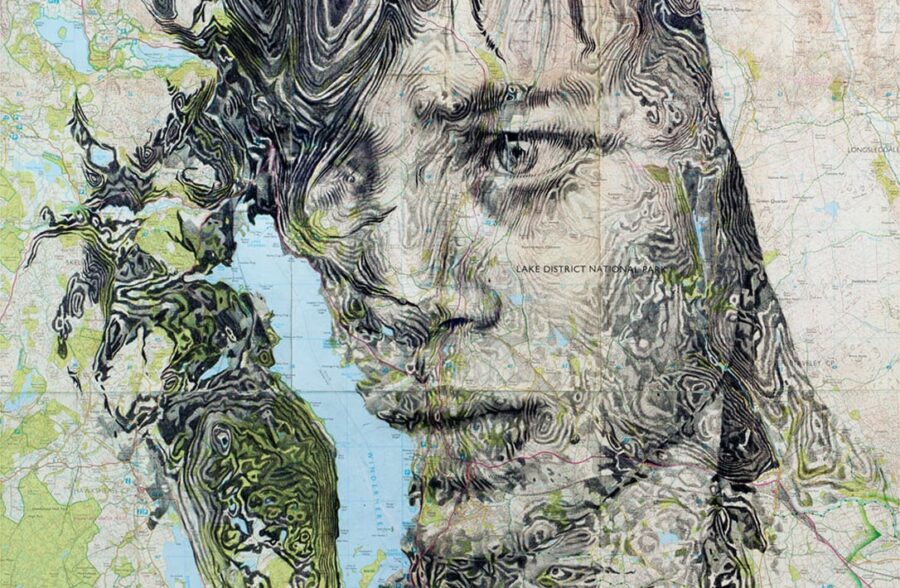A contemporary artist is reviving analogue cartography but not to show us the way, rather to reveal who we are. Ed Fairburn, a British artist from Southampton, turns the once-utilitarian surfaces of old maps into breathtaking portraits. His works merge human and landscape so seamlessly, it is as if they had always belonged together. The result is a body of art as aesthetically captivating as it is intellectually stimulating: Fairburn’s drawings engage with our perceptions of identity, memory, and the individual’s sense of place.
From Map to Portrait
Born in 1989, Fairburn discovered his distinctive artistic language while studying illustration in Cardiff, Wales. In 2012, he began experimenting with everyday objects as unconventional canvases, commandeering envelopes and other found materials to draw portraits. His breakthrough came when he used a vintage road map as his canvas: his exceptional draftsmanship merged with the tangled topography of the map to create a portrait that seemed to emerge directly from the terrain itself. This became the foundation of Fairburn’s future work, a technique he would later call “Topopointillism,” a portmanteau of topography and pointillism.
In Topopointillism, geographical structures and drawing become inextricably intertwined. Fairburn works with traditional materials ink, graphite, watercolor using the existing elements of the map as both guide and partner. Roads, rivers, and contour lines are not simply covered or ignored; instead, he carefully shades and adapts them so that, gradually, the features of a face begin to materialize.
He spends hours searching for the right “anchor points” within the labyrinth of each map, perhaps where a mountain ridge can become the contour of a cheek, or a river the flow of hair. This patient preparation ensures that, as he puts it, he “nurtures” the map’s composition rather than fights against it. The result is a finely tuned mesh of point and line: up close, his works appear abstract, but with distance, they reveal astonishingly lifelike faces. It is a paradoxical visual experience, a portrait that loses detail the closer you look, only coming fully into view when you step back.
Identity Embedded in Cartography
Fairburn’s art is not only an optical feat, but also one of conceptual depth. His map portraits revolve around themes of identity, memory, and belonging. By embedding human faces within a geographical substrate, he poses questions about how profoundly we are shaped by our surroundings.
The map becomes a metaphor for a life’s journey: every road might symbolize a path taken, every contour line a landscape etched in memory. At the same time, the portrait lends intimacy to the impersonal grid of cartography. The abstract network of a topographic map receives a human countenance, while the individual face is set within a broader geographical context. Ultimately, Fairburn’s work reminds us that we are all products of our environment and sometimes, it takes a step back to see the full picture.
Reception and Cultural Resonance
With his original approach to cartography, Ed Fairburn has attracted widespread attention in the art world since 2012. His works have been exhibited in galleries around the globe and eagerly collected by art lovers. As an example of contemporary art that reinterprets traditional materials, his creations continue to resonate with both critics and the public. International media, from art magazines to major newspapers, have featured Fairburn’s map portraits, amplifying their intrigue and reach.
Yet Fairburn’s influence extends beyond the gallery. His visual language has found resonance in popular culture: he designed a cover for a John Lennon special edition and created posters for the Hollywood “John Wick” film series. Such commissions underscore the universal appeal of his map portraits.
Cultural institutions have also recognized the unique significance of Fairburn’s oeuvre. The renowned Newberry Library in Chicago home to one of the world’s most important historical map collections recently acquired one of his works. A contemporary portrait on a vintage map now resides in an archive of classic cartography: a remarkable bridge between centuries-old mapping and contemporary art.
By animating old maps with human faces, Ed Fairburn builds a poetic bridge between person and place. His art reminds us that even in the age of GPS, the analogue map still has countless stories to tell stories of origin, belonging, and the traces we leave on the world. Fairburn’s portraits invite us to see the world anew: as a dense web of memories, places, and identities that connect us all. In the end, his art, like a map, helps us locate ourselves in the world.









